The ultimate guide to growing your boutique fitness business with facebook video ads
Business owners and consumers have a broad range of opinions about Facebook ads.
Recently, I asked people for their gut reactions to sponsored posts.

Here are a few of the responses I received:
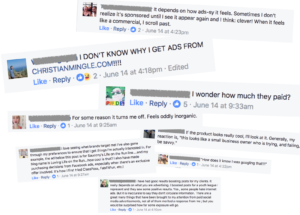
I get it. It’s hard to make a blanket statement about Facebook ads because there are varied results.
- You hear about businesses that have never paid a penny in Facebook advertising and have massive success.
- You also hear about businesses that ONLY do Facebook advertising and also totally crush it.
- And then you hear about businesses that tried one or both of the above strategies, and their results sucked. Perhaps one of those businesses belongs to you.
You also hear that Facebook ads are expensive.
This reputation persists because entrepreneurs try to run a Facebook ad once, on a whim. They set it up themselves, rush their strategy, see lackluster performance, and decide that a platform with two billion people using it “isn’t for them”.
Using video ads, however, you can get in front of people for LESS than a penny. You can then target fun and engaging posts to just that audience again and again.
That’s currently happening with my friend Brian, an online personal trainer:

He reaches new potential customers for four-tenths of a penny.
If reaching potential clients and customers for that price interests you, read on.
*
WHY WE ARE HERE
If you’re reading this guide, you want more clients and more sales. Period.
To get more clients and more sales, your marketing must achieve two things:
- It must get you in front of as many ideal customers as possible. (Ideal customers are those who are willing and able to pay.)
- It must guide these ideal customers to know you, like you, trust you, and eventually throw money at you.
You want a resource that gives you these results.
You also want a resource you can reference again and again, so you don’t have to memorize lingo or which buttons to press.
This guide will also show you the unpaid Facebook strategies you should have in place FIRST before you jump into paid advertising.
You may also consider downloading this guide as a PDF for future reference – you can do that below.
WHAT YOU WILL LEARN
I’ve divided this guide into four main parts.
In Part I: Your Online Marketing Plan Of Attack, you get an overview of both free marketing strategies and paid marketing strategies that involve Facebook. You’ll discover which strategies make sense for your unique business – and which ones you should avoid.
In Part II: From “Brand New” To “Brand Ambassador”, we’ll attack how to tweak your marketing for new students versus your existing students. This custom messaging often makes a big difference in revenue for fitness studios.
In Part III: Build Your First Facebook Ad, we’ll hold hands as I take you through every step of the Facebook Ads Manager. I’ll point out the snags and obstacles that trip most business owners up – putting you ahead of 98% of the competition.
In Part IV: Analyze, Optimize, Customize, I’ll show you some more intermediate tools you can use to take your advertising strategy to the next level.
WHAT YOU WILL ACHIEVE
First, you will get more clients and more revenue.
Other residual results may come from that, such as Facebook page likes or more engagement. Those are vanity metrics though, and we won’t obsess too much over them. We focus on metrics that cause more clients and more revenue. Clients and revenue.
I’ll type it again. Clients and revenue.
Second, you will have a marketing strategy for your business that you feel confident in.
No more mimicking the competition. No more reactive flash sales. No more quick-cash marketing that only gets you more stuck.
Third, if paid advertising becomes your jam, you will create multiple winning campaigns over time, which will stack your Facebook efforts into a well-oiled revenue-generating machine… OF DEATH.

Let’s do this.
THE TOTALLY TUBULAR TABLE OF CONTENTS

Part I: Your Online Marketing Plan Of Attack
How to balance free (organic) marketing with slam-dunk paid marketing
- Why Facebook is a treasure trove of potential clients and fanatics
- The organic growth strategies you want in place first BEFORE you ever pay a penny to advertise
Chapter 2: The best strategies for boutique fitness business membership growth
- How “phantom pricing” sets your business up for maximum membership revenue
- How to use habit-building psychology to convert more members
Chapter 3: “When should I run ads?” The most lucrative times of year for studios
- The three times of year that are most lucrative for health and fitness services
- Using ads just during promotions, versus using ads year-round: Pros and cons

Part II: From “Brand New” To “Brand Ambassador”:
How to show up for prospective clients vs. your existing fanatics
Chapter 4: The “More Traffic” Strategy: Spread the word about who you are
- Why not all media is created equal
- How “video views” are a magical marketing potion for studios
- Why a Facebook ad to a new audience must use the “Charming First Date” approach
Chapter 5: The “More New Students” Strategy: Attract more leads and convert more clients
- How to hack through social noise using the “one sharp axe” method
- How to create a Facebook ad that runs on autopilot only to people who haven’t taken a class yet
Chapter 6: The “Members For Life” Strategy: Use Facebook ads to retain your existing members
- The Third Place Phenomenon
- The compounding power of retaining more members
- The best promotions and challenges that retain already-paying clients
- How to encourage authentic referrals in a concentrated period of time
- How to use a sponsored post to encourage more word of mouth referral

Part III: Build Your First Profitable Facebook Ad
Without Clawing Your Eyes Out
- “How do I get charged for Facebook Ads?”
- Why setting up Facebook Business Manager doubles team productivity
- The only two (and a half) tabs you need to care about in Business Manager
Chapter 9: Objectives: Choosing the right ad structure for your business goals
- The two questions to ask yourself that immediately clarify your promotional goals
- Which objectives will make your posts look most natural
Chapter 10: Ad Sets: Identifying your ideal audience and budget
- Breaking down the audiences tab
- Where you should place your ad based on your strategy
- Running your ad on instagram – do’s and don’t’s
- How to keep your budget under control
Chapter 11: The Ad Itself: How To create a killer ad that makes viewers take action NOW
- Image versus video and considerations
- How to ensure your ad content is compelling and easy to read
- Formatting tricks that ensure your message gets across
Part IV: Analyze, Optimize, Customize
Refine your marketing efforts to reduce costs and maximize happy students
Chapter 12: “Is This Good Or Bad?” Measuring The Results Of Your Facebook Ads
- Setting up the Facebook Pixel
- How to target someone who began a purchase, but did not finish
- How to use a “conversions” ad to measure your effectiveness and stay on budget
Chapter 13: Sell more teacher trainings, workshops, and certifications with the Facebook Pixel
- How the Facebook pixel tracks people that visit your website
- How to use Facebook Pixel to promote higher-dollar programs such as teacher trainings or miniseries
- How to use a “conversions” ad to measure your effectiveness and stay on budget
ABOUT ME
I’m the Marketing Director of a boutique fitness business, and previously have been a Chief Operating Officer and a full-time instructor.
I was skeptical about marketing and paid advertising strategy for a long time – it seemed like an unnecessary expense to me.
But here’s the thing:
People love — LOVE — going to studios to workout. Demand was not the issue. Visibility was the biggest roadblock for most local small businesses and entrepreneurs.
You can have all the passion and drive in the world for health and fitness, and it does not matter if you are getting lost among hundreds of other brands out there.
I wrote this guide to give you an upper hand and discover how to use strategic Facebook advertising to market your business in a powerful, authentic way, and leapfrog the competition by showcasing what you do best – helping people feel great!
I also write for Huffington Post and ClassPass, and I am a featured case study for Ramit Sethi’s “Earn1K” consulting program.
Also, I enjoy donuts, as shown here:

That’s all for now.
Chapter 1: The #1 Biggest Mistake Studio Owners Make When Using Facebook Ads – and How To Leapfrog Over It
You’re probably frustrated about one of two things.
One: You need more NEW people to come to class and become members. When you post to social media, you’re met with plenty of likes and positive affirmations – but none of that is translating to dollars, and you’ve got bills to pay.
Being popular is fun, but it isn’t fueling your business.
OR
Two: Your existing clients and members tune you out (because newsletters are boring). The average adult gets 121 emails a day, so can you blame them?
They taper off and eventually leave you. You need another way to get in front of people who have previously bought from you, and persuade them to come to class again and again.
The #1 mistake business owners make when using Facebook Ads is they sell too hard to customers that don’t fully trust them yet. This comes off as shady, sleazy, and impersonal.
The way to leapfrog over this fatal mistake is to advertise the right ad for where your customer is in getting to know you.
So before we dive into all the nitty gritty with Facebook ads, we’ll get clear on the parts of a sales funnel that are unique to a fitness business. This clarity alone will put you ahead of 95% of the competition.
Let me explain. Whether you do all free marketing, all paid marketing, or a mix of the two, your audience is always somewhere in your “sales funnel”.
A sales funnel looks like this:
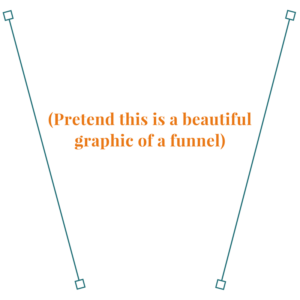
People enter your sales funnel when they become aware of you. Advertisement, media write-up, recommendation from a friend, hashtag, driving past the studio, googling you, and so on.
This is called your TRAFFIC. The viewer goes from never having heard of you to discovering you.
As you can imagine, without traffic, nothing works. So the first step is to do what it takes for people to discover you.
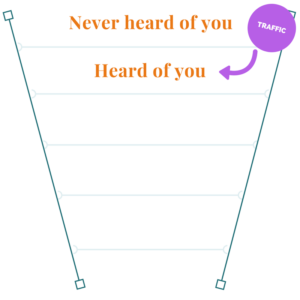
Some of the people who hear about you will do nothing or ignore you – that’s normal. Often they need to see or hear your name multiple times before they decide to learn more. Also, your message can’t be boring, or else you’ll be ignored – don’t be afraid to shake it up.
Others, however, will follow your social media pages or join your email list. These are your LEADS.
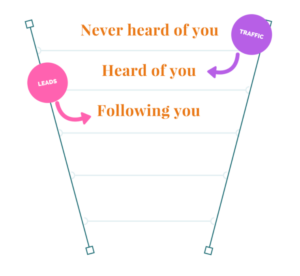
Leads can be a loose term in fitness businesses. In this funnel, we’ll define leads as people who are following your pages.
They’ve chosen to connect with you and get updates. This choice moves them deeper into your funnel and allows you to market to them again and again.
Not all leads and followers are created equal
Even if your page has a lot of followers, you only get in front of a fraction of them with free marketing or posts. Facebook is designed that way.
Here’s an example – the studio below has 9,600 page likes. Pretty good.
This post – which promotes a quality training that empowers teachers – only reached 6% of their followers.

Play the Facebook algorithm, or the Facebook algorithm will play you.
To get in front of more of your followers, you can pay to advertise, or you can try to create content that goes viral.
The good news is that people are on Facebook – a LOT. Facebook is designed to be addictive. So if you’re confident that your content is great – which you will be after this guide – it’s worth it to spend some dough on advertising and get in front of more of your people.
(Also, as an FYI, you could upload your email list into Facebook and target JUST your subscribers with Facebook ads – another inexpensive way to get your message out to already-engaged clients. We’ll tackle exactly how to do that in Chapter 5.)
Now – some of your leads who follow you will try you out – they buy from you. These are called CONVERSIONS.
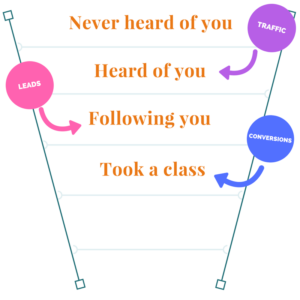
Conversion is a huge step, because not only have people given you some of their money, but they’ve also invested effort to figure out where the class is and actually take class. There’s a deeper level of investment from this group of people.
There’s a great quote by Jeff Eisenberg: “It’s much easier to double your business by doubling your conversion rate than by doubling your traffic.”
It’s true. You don’t need a pricey TV spot or radio commercial. Just convert more of your existing traffic to leads and leads to conversions.
Now, particularly with fitness studios, where you intend for people to visit again and again, the real revenue comes when new students become regulars or members. This equates to hundreds or even thousands of dollars over time. We’ll call this RETENTION.
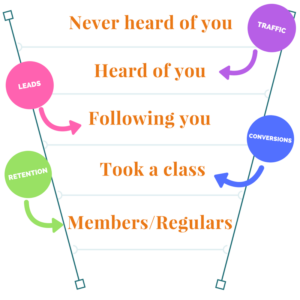
DING. For most businesses, conversion and retention marketing are where Facebook ads create massive gains in revenue.
Most business owners know this. But they mess it up – they take an ad that should go in front of this audience, and just promote it to everyone, which turns off potential traffic and leads. It’s too hot out of the gate.
Let’s look at an example. Here is an ad I saw recently for a studio I have never been to:
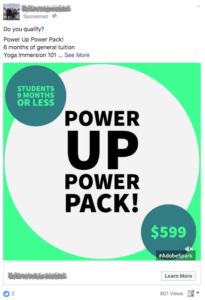
I HAVE NEVER BEEN HERE. I don’t even follow this business’ Facebook page. So why would I commit to a 6-month package and drop nearly $600?
I am in the “Never Heard Of You” stage of this studio’s funnel – I’m barely in their funnel at all, really – so this feels like you’re asking me to marry you on the first date.
We need to be wooed and charmed a little more before we can make a commitment.
This ad would have been more appropriate to target to existing members who already pay and love the classes, and are ready for a bigger investment.
*
Finally, some of your regulars and members are fanatics – they freaking love you. You know these people – they’re the ones that bring new friends every week, go to all of your events, follow your instructors on instagram, and buy all of the swag. This group is small, but very, very mighty.
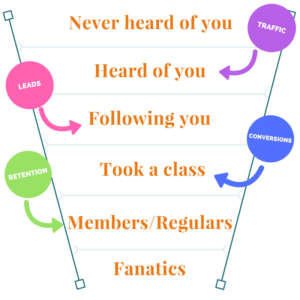
We love fanatics. A single fanatic might bring you 50 new students, encourage 10 new members, and post about you on social media 100 times. Fanatics drive free traffic like crazy – because they love your brand.
For your business to cultivate fanatics, you need
- A brand, mission, and message people want to get behind
- An experience that is quality and fun
- FOMO (Fear Of Missing Out) – you throw events that people don’t want to miss
More clients and more revenue doesn’t necessarily mean “get more people from everywhere, all the time.”
For example, you could aim to increase the number of conversions (your new students) that go on to become members or regulars – that would massively increase your revenue.
Or you could send an advertisement to just your fanatics, inviting them to learn more and potentially enroll in an upcoming program, workshop, or teacher training certification.
*
Now that we’re clear on traffic, leads, conversions, and retention, you can identify which step of the funnel needs the most attention.
Want to be seen by more people who haven’t heard of you before? Focus on getting more traffic. Facebook Ads and Google AdWords are two common paid vehicles for this – which is why this traffic is called paid traffic.
Want to grow your email list or figure out who’s actually interested in your business? Focus on getting more leads (people who are following you or are your email subscribers). Create awesome and fun content, then use some of your advertising budget to share that content with new people.
Ready for more revenue? Focus on how to convert more of your leads into conversions, and how to prolong retention. Paid ads that go directly in front of your already-interested followers can do the trick.
Do I think you need to be spending hundreds of dollars on social media right out of the gate to convert people? Hell no. It’s best to start small.
It’s completely possible to grow your following and your message without Facebook ads. You don’t NEED to do it.
If you’re not paying for traffic, though, you need to have a traffic strategy in place that will get enough people in the door. Otherwise, your funnel will dry out.
Why Facebook and Instagram are treasure troves of potential clients and fanatics
It’s simple – their eyeballs are on Facebook on Instagram anyway!
Chances are that most of your target market is already on Facebook. Here is a graphic of growth in Facebook users over time:
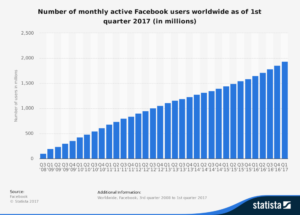
It’s not going away anytime soon.
Facebook usage also grew rapidly – in Q4 2016, Mark Zuckerberg confirmed that users in the US now spend an average of 50 minutes a day on Facebook and Instagram.
I make two assertions here:
- A lot of your ideal clients are on Facebook.
- Based on data, they are on Facebook/Instagram for about fifty minutes a day.
Your mission is to get in front of those people and charm the crap out of them.
To conversion… and beyond
Focus your marketing on getting more people to see you. Then move the people who saw you toward subscribing to your updates and, eventually, conversion.
After that, repeat sales become much easier and marketing costs go way down.
In this guide, I discuss how to use Facebook Ads to achieve all of these objectives. Some other free tools you might like to sharpen up your conversion are:
Conversion Marketing Playbook: Health and Fitness
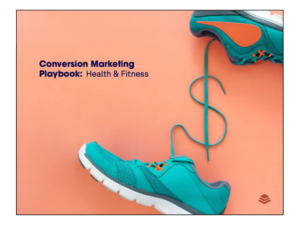
LeadPages recently authored this free guide – they are a leading software that provides landing pages (simple web pages you can connect to your website and build in minutes). We’ll discuss them throughout the guide as a way to increase conversion.
You can check out LeadPages here. (Also, yours truly is featured as one of six experts.)
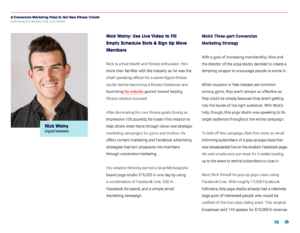
The Complete Beginner’s Guide To Monetizing Facebook Live For Fitness and Yoga Businesses
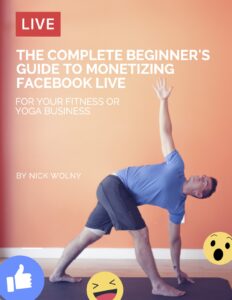
In my guide to monetizing Facebook live, I talk about how to leverage your likes and followers and move them toward conversion using a viral Facebook Live event.
In one case study, we break down how a local yoga studio made $15,525 in 24 hours using Facebook live and $50 in Facebook ads.
Before we get our hands dirty with ads, though, we want to be clear on which strategy makes sense for our business, which unpaid strategies we should already have in place, and which times of year are the most lucrative for fitness businesses.
That comes next
Chapter 2: The best strategies for boutique fitness business membership growth
You don’t want to spend time or money on traffic until you have a killer funnel in place that maximizes revenue. This chapter clarifies the strategy behind your sales machine.
Some fitness businesses are a hybrid in that they offer both memberships and drop-in packages.
Others are building intimate membership experiences.
And others still will take on the challenging (but also lucrative) task of offering drop-in rates only and asking clients to book each class individually.
Each of these models can be successful. Each also requires a slightly different brand and marketing approach.
We mainly tackle how to market a hybrid membership model in this chapter and in this guide. However, the concepts can apply to any fitness business, as they focus on pricing psychology.
THE THREE CORE BOUTIQUE FITNESS BUSINESS MODELS
Model #1: Hybrid
Some high-level highlights of the hybrid business model are:
- New students try you out for an introductory period of time (2-4 weeks is ideal), not for an introductory class.
- Your funnel points toward a membership, but you also sell blocks of drop-in classes.
- Your business’ classes have a larger capacity – over 30 people can be in one class.
- You can run sales on your drop-in class packages, or trade drop-in classes to develop media relationships
A hybrid model is the most popular boutique fitness business model.
As the name implies, you’re offering both an a la carte option and a membership option to members, which allows you to cast your net wide. Here is an example of package options in a hybrid model:
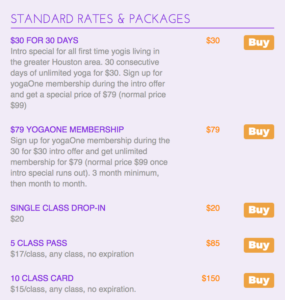
In this example, people can purchase either class passes or a monthly membership.
I LOVE this business model because you point to membership in your marketing efforts, which allows you to build monthly recurring revenue and community. You also provide a la carte class passes to appeal to people with unusual schedules or who just like to bounce around.
For example, I live in Houston, Texas – a lot of young professionals here work in offshore oil and gas. They have killer salaries – but their work sometimes requires them to leave town and go work on a rig for two and three-week increments.
A membership doesn’t make a lot of sense for this audience, yet they’re able and willing to pay a premium for studio services, a change of scenery, and the feeling of connection.
Type #2: Membership Only
You’re familiar with the membership-only model – it’s the common model for big-box gyms like LA Fitness or Gold’s Gym.
Some boutique personal training studios or CrossFit gyms may also choose this model. Some high-level highlights of the membership-only business model are:
- The feeling of belonging and community – everyone knows that everyone else is a member
- You will technically lose revenue from clients that like to bounce around town. However, the people you do have are deeply committed to you, and they become fanatics quickly.
- Budgets and financial planning are easier since the vast majority of your revenue comes from membership.
Membership-only model is for you if you’re passionate about only having people who are dedicated to their fitness and come on a regular basis. In a boutique studio, a membership-only model can help generate an incredibly tight-knit community.
Inherently, there are people who prefer not to commit – they like to bounce around, or they travel a lot for work. It’s simply their preferred buying style.
If your business is membership-only, you’re missing out on a segment of your market that would actually love to work out with you, but can’t really take advantage of an unlimited-access membership option.
You might consider having a higher-priced single drop-in pass to allow a little flexibility – it’s enough to provide one-off participation, but doesn’t encourage a noncommittal regular student.
An example here in Houston is CrossFit EaDo. CrossFit EaDo markets itself as the biggest CrossFit box in Texas, and their large membership base has allowed them to grow custom programs unique to people’s needs.

A large, tight-knit community allows custom programs to thrive.
CrossFit Eado has one drop-in option: A single drop-in for $30 (which includes a free T-shirt). Otherwise, it is membership only.
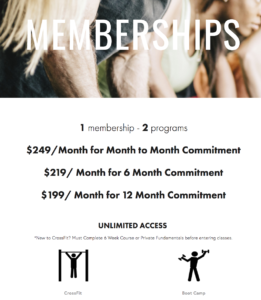
Type #3: Drop-In Classes Only
At the other end of the spectrum is a business model that offers drop-in classes only.
A drop-in only model is challenging, exciting, and gives the opportunity for maximum profit. It works best in studios that have a limited number of spots per class.
Highlights:
- Limited capacity in classes because of room size or machines. Since there is not membership option, there is no supply glut from having too many members.
- Opportunity to charge higher prices because of the limited availability. Common to charge $25+ per class.
- You’ve gotta be damn good – people only pay when they actually workout.
- Fertile soil for a “local celebrity” culture – instructor personality is a huge factor, because a bigger audience and following means more revenue.
- If it’s a holiday, or there’s a natural disaster, and you cancel classes, you make no money that day.
In this model people pay per class and can pre-purchase blocks of classes, which usually have a tight expiration window (for example, a 5-class pass would usually expire in 45-60 days.) This forcing mechanism makes people work out.
Obviously, this model presents challenges – if it’s a rainy day, you’re not going to make much money. But it’s an awesome option for businesses that have a limited number of machines (cycling, reformer pilates, or barre) or spots in class.
If you have limited space, this might even be your preferred model. Too often I hear about reformer pilates studios with a class capacity of 10 that are in a huge supply glut because they have too many members who want to hit the 5:30pm class 5 days a week.
Those businesses are using a hybrid model, and it’s actually hurting them. They should be on a drop-in model instead.
A drop-in approach is also fertile ground for creating a fanatic culture – people will begin to buy and book ahead of schedule for their favorite instructors’ classes and class times.
When a class has a reputation for quickly selling out, it automatically becomes more popular and intriguing to your community, and people happily pay full price to go to these classes, preserving your profit margin.
This model also lets you drive higher profit – With a drop-in only model, instructor pay can be pay-per-head, and you can incentivize instructors to fill their classes.
Drop-In structure has become more popular, and leverages social media heavily, as you depend on the instructor’s skill and personality to fill classes.
How SoulCycle gets away with charging $3,500 for a 50-class pack
Every Monday at 12pm, SoulCycle opens its schedule for the week and emails its riders. Some classes fill up in seconds, selling 60+ bikes in a room at $30+ a class.
So the NYC-based chain created “Super Soul” – a package of 50 classes for $3,500. With Super Soul, you pay a premium, and receive the “schedule open” email one hour early, along with some other VIP perks.
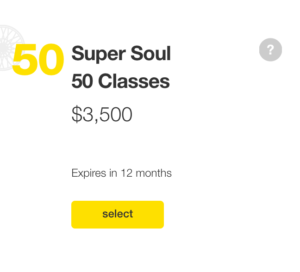
How on earth can a studio get away with charging $70 a class?!
Well, the celebrity culture at SoulCycle is so strongly defined (particularly in “celebrity” markets like NYC and Los Angeles) that riders are willing to pay the big bucks to get the exact class, instructor, and spot they want. The high price point is also far too steep for most tourists, since you only buy in a block of 50 classes.
This exclusivity fans the fanatic flames. Your instructors must be damn good to attract enough fanatics, but when they do, your classes can be very lucrative.
*
How “phantom pricing” sets your business up for maximum membership revenue
In a hybrid or membership model, membership is king. Here are two steps to take to perfect a business’ membership pricing model.
First, find out how often people visit your business per month, on average. Go by data if you have it. Is it 3 times a month? Six? Eight?
(Believe it or not, the average visits/month for yoga studios is 3.9 and the average for big-box gyms is 2.9. Don’t get too optimistic here.)
For a hybrid model, you need to position your pricing such that a membership is less expensive than purchasing that number of drop-ins a month.
Let’s say a barre studio is seeing people seven times a month on average. You should position your membership such that being a member would be less expensive than buying seven drop-ins – even at the lowest per-drop-in price.
If a drop-in is $20/class, you want you membership to be UNDER $140 ($20 x 7) per month.
That’s step one.
Now for step two, you need to introduce a phantom price.
This goes back to pricing psychology, which Dan Ariely hilariously and beautifully demonstrates in this video.
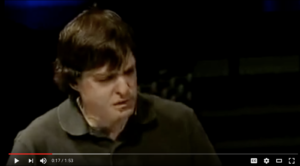
Your target membership price should be framed as a deal. Introduce a phantom membership price that is at least 30% higher. For our barre studio, that would then be $185 a month.
(You could also do more – $199 month, et cetera. But you need to do at least 30% to create some impact.)
You then market that, while people are in their introductory special, they are eligible for the lower membership rate.
*
This studio now has a clear funnel. They can promote to all new students that
- You can try them out for an intro offer of ______
- During your intro offer, if you decide to become a member, you’ll lock in a membership rate of $140/month (normally $185/month).
As a diagram, that looks like this:
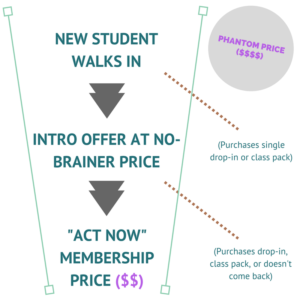
And there you go! When you frame membership as the best deal financially for people, you’ll retain more new students into members.
How to use habit-building psychology to convert more members
If you’re a membership-only or hybrid business, you want people to eventually become a member. You need them to get accustomed to the feeling of being a member.
I recommend you create an intro offer that is two to four weeks in length. If your capacity can handle it, do four weeks.
The intro special should also be a steal of a deal. I recommend you make your intro offer 30%-50% of the price of your monthly membership.
In this example which we saw earlier, the intro special is one month for $30, which funnels into a membership price of $79/month. The phantom price (not shown) is $99/month.

You want to be selective with discounts so you don’t cheapen your brand or train your students to wait for the next sale.
For newer students though, give them an opportunity to come check you out multiple times. This will help them get hooked on how great your classes are!
It usually takes more than one class for a student to really feel hooked and see themselves incorporating the studio into their routine on a regular basis.
Free intro offer versus paid intro offer
If you’re a membership-only or hybrid business, ALWAYS do a paid intro offer – even if you’re newer and want lots of people in the door. This builds your membership funnel and keeps class quality up.
For a drop-in model, you have a choice.
If you do a free intro offer, you’ll get a lot more people coming in. It’s also very easy for your regulars to bring a friend.
The catch is that the quality of people coming in can be all over the place. It’s also likely that you’ll have people no-show, try to cheat you, or disrespect the rules of the class.
No-shows happen a LOT, since there wasn’t any buy-in to begin with. If your class size is especially small (think reformer Pilates, for example), I wouldn’t do free – you don’t want half a class to be taken up by first-timers who paid nothing to be there and may not show, while your willing-to-pay people are left wishing they could get into class.
A paid first class at a lower rate will create lower total traffic, but those people are more likely to be committed to the class to begin with.
My personal vote is that your new student offer is always a paid offer.
*
Now we’re much more clear on your funnel, your offer, and what you want to market people toward.
Next, we’ll tackle the best times of year to market big promotions or initiatives that build your studio attendance.
Chapter 3: “When should I run ads?” The most lucrative times of year for studios
But wait.
What if you take all this time to read this guide, and spend all this money, and then it turns out that people were on vacation when you tried to launch a sale? Crap!
There are two major approaches to using paid Facebook and Instagram ads for your fitness business:
- You use them occasionally, when you’re promoting to leads and customers, to spread the word about sales or special promotions. (My guide on Facebook Live leverages this approach.)
- You want steady advertising year-round to drive more traffic, leads and sales to your business.
In either case, there are three dominant times of year in which you should ramp up your promotional efforts. In this chapter, I give you those three pillars.
This doesn’t mean you can’t do a promotion whenever the hell you want. These three windows have the benefit of consumer psychology on their side.
At the end of this chapter, you can also swipe a Google Sheet I’ve created for you that has promotion ideas throughout the year.
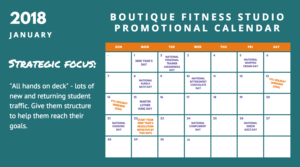
The three most lucrative times of year for health and fitness services
The natural traffic of studio attendance falls into three major buckets.
One of them is extremely lucrative because people are in a reactive state. For the others, people are in a largely proactive state – but there is still an impending disaster on the horizon.
The three times of year to launch a promotion or challenge (in the Northern hemisphere) are Beginning of year, start of summer bucket, and September reset.
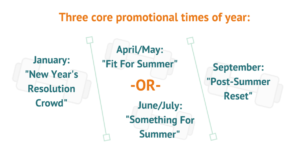
Let’s unpack each in more detail.
Promotion Period #1: New Year’s Resolution Fever
(Launch/Start date: early to mid-January)
January is the most lucrative time of year for fitness services. Here’s why:
First, people feel like crap after the holidays. They’ve attended parties, traveled, and celebrated – sometimes for a month straight.
It’s a long enough period that their unhealthy behaviors, while fun, are starting to become habitual. Maybe they’ve also put on some pounds and their clothes are fitting a little too tight. They need a jumpstart.
Second, there’s a new year – people are contemplative about what they want more of in their life.
While they may not set an explicit new year’s resolution themselves, other people around them are, and there is much more day-to-day conversation about dreams and goals. (Health and fitness goals are the number one new year’s resolution, beating out number two in January Google searches at a 2:1 ratio.)
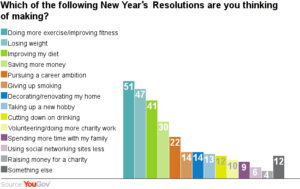
This group has very tangible pain points NOW, because they look and feel like crap. Your most aggressive campaigns, challenges, and programs of the year should launch in JANUARY.
An example program is to facilitate Baron Baptiste’s “40 Days To Personal Revolution” program at a yoga studio in January.
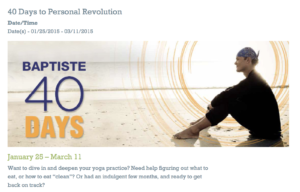
Example of a studio hosting a challenge during promotion period #1.
This program can be offered at any time, as it’s based on a book. By offering structure at the beginning of the year, you’re more likely to retain and convert your new year’s resolution crowd.
Why the new year’s crowd gives you 40% of annual revenue
Quick story.
When I worked for lululemon, I remember the first time we received the holiday planning kit – it arrived in June. JUNE.
I died a little on the inside. I thought it was crazy at first to be talking about Christmas six months in advance.
But then I overheard a killer statistic: 40% of the store’s revenue for the entire year was earned in the three-month period between November 1 and January 31.
Sure enough, that’s how it would play out – usually.
In some holiday seasons, we had all our ducks in a row, we followed the holiday plan and were proactive, and we absolutely crushed it – making hundreds of thousands of dollars in additional sales.
In other years, we had the wrong people or not enough preparation. It cost us dearly and we missed our sales targets – by a lot.
Sure enough, when I later worked in studios, this was also true on the fitness side – the peak quarter of the year pulls in about 40% of the entire year’s revenue.
For most studios, this is the period from December 10 – March 10. (A lot of December transactions were people splurging on annual memberships, which make a big dent.)
Whether you like it or not, a TRUCKLOAD of new people come through the doors at the beginning of the year.
Lots of people are ready to pounce and spend on the services that will fulfill their new year’s resolutions – as well as get them out of the post-holiday muck as quickly as possible.
Promotion period #2: Post-Summer Reset
(Launch/Start date: September)
The other consistent time of year to create a large-scale promotion or challenge is in September.
There’s often a spike in attendance or interest in early September, as people make their way back into the studio. Families finish up their summer activities and vacations, and the kids return to school.
Your students are ready to recommit. They may also still be traumatized from last holiday season when they ate their weight in sugar.

You can position your September effort as a pre-holiday opportunity where people can go into the holidays feeling good about what they’ve just accomplished.
I recommend you start this promotional period anytime in September, and wrap it up before November 15th.
Promotion period #3: “Fit for Summer” OR “Something For Summer”
Launch/Start date: April/May (Fit For Summer), June/July (Something For Summer)
Your third promotional time of year should be EITHER a “Fit For Summer” challenge focused on nutrition and fitness, or a “Something For Summer” challenge focused on attendance and participation – but not both.
Why not both?!
You don’t want to exhaust your market. Two challenges in a three-month period is too tight – especially if you’re going to charge for people to participate in the challenge (for example, a six-week “Paleo challenge”.)
If your market resonates more with the “Fit For Summer” message and want to tighten their nutrition and show off their beach body, do a promotional program in April or May.
Business who run strong nutrition programs, CrossFit boxes, or boutique personal training businesses usually benefit from this approach.
Perhaps your market isn’t as obsessed with their beach body, but want a fun challenge to keep them motivated for the summer – if this is more your studio’s flavor, I recommend doing a “Something for summer” challenge that is focused around attendance, and doing it sometime between late June and early August.
No matter what time of year you’re reading this chapter, you have a psychology-backed promotional window coming up soon – get creative! And know that these programs can be repeated year after year to rake in the revenue.
To help you get started, I’ve created a simple strategic editorial calendar, which you can grab below.
*
We’re clear on your what, your when, and your why! Now let’s get our hands dirty with the different ways you could go about using Facebook ads to pump up your funnel.
Chapter 4: The “More Traffic” Strategy: Spread the word about who you are
Okay – so we’ve talked about what to promote, when to promote it, and how to tailor your promotions to your unique business.
The next four chapters will each tackle a unique “checkpoint” of our marketing funnel. As a reminder, that looks like this:
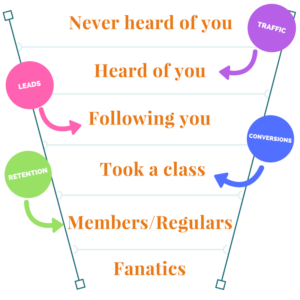
Let’s first discuss how to drive traffic to your promotions. We’ll discuss both free traffic and paid traffic.
Since this guide is about Facebook ads, you can bet your yoga pants that I’ll be recommending you use them as a paid traffic strategy to reach more people.
Why not all media is created equal
Everyone who hears about you (with the exception of people who walk or drive by your business and discover you) does so through some type of media.
There are three categories of media: Owned media, paid media, and earned media.
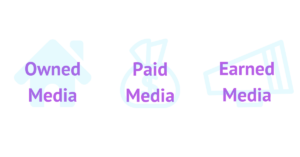
Owned Media consists of the channels you own and have total control over. This includes your website, your social media platforms, and your email newsletters.
You control the experience, which is great – you can say or communicate whatever you want. The catch is that people are not hugely trustworthy of owned media – because they know that deep down, you want them to buy.
Owned media doesn’t really drive cold traffic, since people don’t know about you, but a great blog post or instagram account that rocks hashtags can be discovered or shared by cold traffic.
Paid Media, on the other hand, gets you in front of a TON of cold traffic. The challenge with paid media is that people know that you’ve paid to be in front of them.
You need to be charming on this first pass to win them over and have them overlook the fact that you’ve dropped some dolla bills for them to see you.
Earned Media includes all the really good stuff: testimonials, reviews, word of mouth, and features on blogs, magazines, or TV.
The good news is that earned media builds credibility and trust. If you shared “5 ways to beat sugar” on your own blog, that’s nice. If your article “5 ways to beat sugar” was published in Oprah Magazine or Mens’ Health, however, you would instantly be seen as a go-to expert in your industry.
The less good news is that earned media can be a double-edged sword – whether someone had a great experience or an awful experience, it sits on the internet forever for everyone to see.
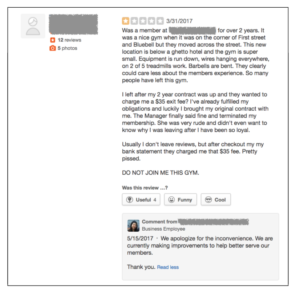
Oh, look, you just got some earned media!
Also – never ever respond this way this girl did. Treat your customers and reviews like family.
Often, businesses will work on doing a ton of owned media, some earned media, and little to no paid media. This can often cause a traffic problem – even with great blogs or funny social media posts, you’re just not getting in front of enough people. Sound familiar?
Testimonials carry a lot of weight – and testimonials on sites other than Yelp are becoming more powerful.
Doren Aldana runs a software business called Testimonial Engine, which can interface with your consumers, collect testimonials, and cross-publish those testimonials to all platforms at the same time.
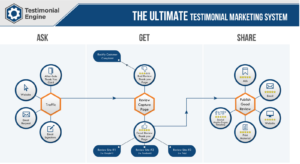
If you’re looking to rapidly build some earned media for your business in the form of testimonials, this could be a great tool.
Doren has a 24-page “Ultimate Testimonial Toolkit”, which you can check out here.
A magic potion called video views
A video post on a Facebook business page will capture viewers who watch for as little as three seconds. This audience is called “video views” and can be seen on any video:

In this video post of my guide, I’ve captured 4,700 people as a future advertising audience.
Video views give an incredible edge when it comes to traffic.
Now when you advertise online to people who have never heard of you before, you can separate the people who showed interest in your video from the people who didn’t.
Then your marketing focuses on converting this “heard of you” traffic into leads. You’ll be able to get in front of them again and again.
Video views are what set Facebook ads apart from almost any other digital marketing strategy. Instead of targeting “people who like yoga” or “people who buy Nike”, which is super general, we’ll be able to target people who were interested in YOU.
We’ll dig into this a lot more throughout the guide – I just wanted to give you a little primer about it now.
Why a Facebook ad to a new audience must use the “Charming First Date” approach
The people who have never seen you or heard of you before are called COLD TRAFFIC. It’s your first time getting in front of them.
And they can be cranky! Keep in mind that Facebook advertising is disruptive advertising – you’re interrupting people’s normal flow of cat videos and silly human tricks to show an advertisement… almost like a commercial.
So we need to “wow” this audience and build trust first. To do that, we use what I like to call “The Charming First Date Ad”.
THE CHARMING FIRST DATE AD
Think back to the time you had a remarkable first date.
It was three hours long and you didn’t look at your watch once. You walked and talked and the conversation was SO easy all night long.
At the end of the night, you get one kiss on the lips – and it feels like magic. You’re left wanting more – like, another three hours more.
SWOON.
This is what we want people’s first ad to feel like with us – we want them to actually be charmed, pleasantly surprised, and curious to learn more.
No selling, no “like us on FB”, no questions, no asking for anything – strictly giving.
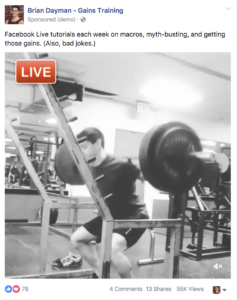
Brian’s Charming First Date Ad is a simple video montage of a few previous live videos.
Can I make a suggestion here? Be fun and entertaining. Perhaps you create a video montage of yoga bloopers, or a montage of testimonials, or just being silly. It doesn’t need to be profound.
You’re paying to get in front of people. It’s an advertisement. OF COURSE you want them to buy something.
But when you come in with something fun, entertaining, and fully giving, you disrupt viewer expectations.
You can also leverage your existing members and fanatics. Invite them to like, comment, and share your Charming First Date Ad to collect social proof.
Chapter 5: The “More New Students” Strategy: Attract more leads and convert more clients
So now people have seen you – cool.
You want to point this traffic to follow your channels, subscribe to your list, and take their first class with you.
As a reminder, we are now here:
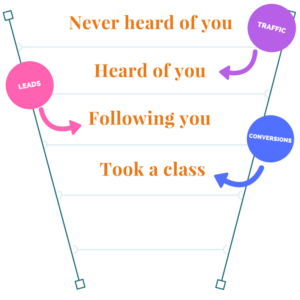
If you ran a Charming First Date Ad like we discussed in the last chapter, you can now create an ad that shows only to people in your “video views” audience who showed interest.
You can invite these people to your intro offer or a promotion, or to check out your website.
(Later in this chapter I will show you how to filter out video views who have already tried you out, which will save you some advertising bucks.)
Too often, I see studio websites with a hundred different buttons and offers. When you have a lot of buttons and announcements, your readers get paralyzed.
Point your audience to ONE offer – your intro offer.
Your intro offer is the lifeblood of your business. It’s also a critical step of the big picture membership strategy I like to call your one sharp axe.
How to hack through analysis paralysis using the “One Sharp Axe” method
We’ve actually already discussed your one sharp axe – it was a diagram in Chapter 2.
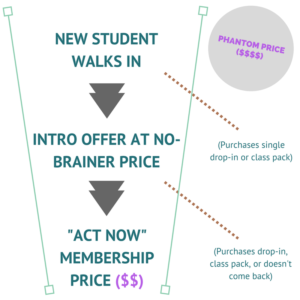
Your sharp axe is the ONE sequence of steps that clients ideally experience. Build all of your marketing efforts to sharpen the one sharp axe.
This sequence of steps should be so clear that a student who loosely follows you (or is not even a member) could explain your sharp axe to their friends.
For example, a yoga studio I used to teach for called YogaOne has been doing an intro special of “30 Days for $30” for YEARS.
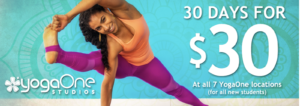
People would often come in and say that a friend told them about the new student special of 30 Days for $30. We would look up the friend. The friend had NEVER VISITED US.
When your sharp axe is strong and visible, people memorize it and you might even see some referrals from it as a result.
How to show just your “charmed video viewers” an ad that offers your intro special
Rather than burn down advertising dollars and beat your existing community over the head with an intro offer they already purchased, I recommend you create an intro offer ad for following cross-section of people:
- They HAVE seen your “charming first date ad” or another video on your page, or they like your page. (It’s not their first time seeing you)
- They are NOT on your email list yet – implying they haven’t been to class before (because they haven’t filled out a waiver or new student form).
The video below will show you how to create this audience. If it’s your first time to use the Facebook Power Editor, you might check out Chapter 8 first; it gives you a full introduction to the Facebook Business Manager.

You can run this ad for as little as $1/day.
If your Facebook advertising efforts bring you in at least that many dollars in new student sales (just a few extra new students a month for most of you), it’s worth it to run this ad perpetually.
*
If a prospective student isn’t biting on your intro offer ad, they need to get to know, like, and trust you more. You want them to like your page or join your email list so you can engage them with unpaid tactics such as posts and newsletters.
A quick way to do this is with a contest. Invite people to like your pages and share a particular Facebook or instagram post. When you put a juicy prize on the line, people will act.
The  best
best  Facebook
Facebook  contest
contest  I
I  have
have  ever
ever  seen (and how your business can do one too)
seen (and how your business can do one too)
Pull up a chair, because this tattoo shop is about to show you how it’s done.
Houston Ink Society Tattoo Company gave away a free four-hour tattoo. The conditions for their contest were:
- You had to like the Houston Ink Society Tattoo Company page.
- You had to like the post in question.
- You had to share the post – and your shared post had to get the most likes.
As you would expect, people went completely bananas:
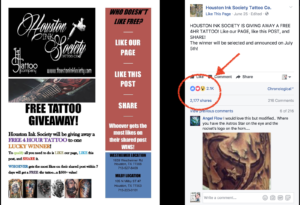
The tattoo shop could have run this as an ad. But really, given the design, they didn’t even need to. Their page surged past 10,000 likes pretty easily – which, as a business selling a visual product, is extremely valuable.
The winning share pulled in over 9,000 likes:
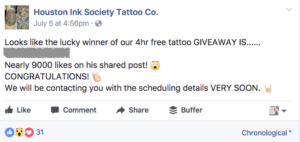
And people were going so nuts that the tattoo shop had to re-explain the rules:

Running a contest like this could be a great way to drum up likes or subscribers, whom you can then keep in touch with.
One last tip – the prize can’t be “a month of free classes” or a t-shirt – that’s lame. It needs to be BIG. A round-trip flight home for Christmas. A $500 visa gift card. A four-hour tattoo. Get creative.
The next chapter tackles the oh-so-important strategy of retention – read on.
Chapter 6: The “Members For Life” Strategy: Use Facebook ads to retain your existing members
Anyone who works in a membership-based operation knows that retention can make or break a business.
You busted your ass to get these people in the door. You swooned them and connected with them. They tell you you’ve changed their life.
And then, POOF – two months later, they cancel, and you never hear from them again. What gives with that?
The rate at which your members turn over is called churn. Reducing churn is just as valuable as a massive campaign to get more members.
Now, some students are going to leave you for reasons you cannot control – they’re moving, they have a health issue coming up, or they just need a change of scenery for a little while. It happens.
To reduce churn, cultivate an environment where people not only get their workout, but also a community. This concept is called “Third Place”.
The “Third Place” Phenomenon
The saying “third place” was originally coined by Roy Oldenburg in his book The Great Good Place.
He writes that people must have a “third place” (the first two are your home and your workplace) where they can establish social separation and create community.
Fitness studios have become people’s third place. You’ve totally seen it. For many people, happy hour is no longer the bar or the café, but a Wednesday night run club or an upcoming yoga class with a live DJ.
Create events and experiences that help members make your studio their “third place”.
How better member retention compounds studio revenue
Just so we’re on the same page – great member retention makes a big financial difference. Let’s hold hands and look at some numbers together.
Let’s say you’re an established studio. About 80 new people try you out each month, about 15% of those newbies become members, and you see 2 or 3 member cancellations a week (10 per month).
Your monthly build looks like this:
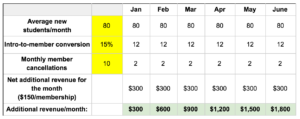
You’re getting 12 new members each month, but since ten have cancelled in the same timeframe, you have a net of two new members/month.
I mean, it’s ok. Your revenue build is slow. Hopefully the toilet doesn’t break.
Now let’s take the EXACT same chart – but say you host more fun challenges and keep your members engaged. Your cancellations drop to 1 or 2 a week (six per month). Your chart now looks like this:

There’s a DRAMATIC difference over time – more people experience your studio as their “third place”.
Now let’s say you use the different tools in this guide to pull in just a few more new students each month. (Let’s say 20 additional newbies a month – that’s less than one per day.)
Let’s say you converted just a few more of those new students to members each month – let’s say two more per month.
And let’s say you kept them engaged, and sustained your churn of 1-2 cancellations a week.
Buckle up – your additional revenue per month now looks like this:
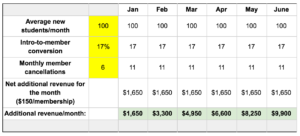
Here’s what this looks like over an additional six months:
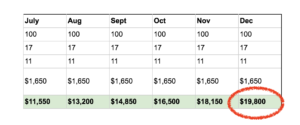
An extra $19,800 per month? I’ll take it.
Why use ads to reach members when I could just use email instead?
Use both.
Email is obviously valuable because it’s free.
With email though, it’s challenging to get your open rates (the people that actually open your email) up.
Even the most tantalizing email subject line might only command a 20-30% open rate – meaning that your retention efforts are only getting in front of a fraction of your audience.
Supplement your email efforts with a Facebook ad pointed directly to your customer list, and a much larger percentage of them will be aware of upcoming events. (Again, it’s possible to upload your business’ email list into Facebook and target only those people.)
You can even call out your members or regulars at the top of your ad with brackets so people know that this sponsored post is special to them and not just a blanket advertisement from your studio.
What should I promote to members?
Create initiatives that get people into the studio.
People usually cancel their membership because they fall out of their routine of going to class, and then develop the habit of not going.
Here are four engagement strategies to get you started.
1) Specialty Classes or Events with Phantom Prices
I consider a specialty class to be your existing class or service with a twist – NOT a workshop or larger intensive.
Easy examples: “Beyoncé-themed Pilates class”, “Yoga in the dark with glow sticks”, or “Grown and sexy yoga” (My friend Tamika did this one).

Tamika’s “Grown and Sexy Flow” class took an existing yoga class and added a dark chocolate and wine social afterward. FOMO was achieved and 75 people attended.
The advantage to a specialty class is that people are familiar with how the majority of the class will go. It’s also very easy to execute.
Remember – we want to engage existing members and give them a reason to continue membership.
You can also create a series of events at outside locations that are higher-price, but free for members.
We did this while I worked for YogaOne Studios. We created a series of events called the “Summer Sweat Soireés” to engage members throughout the summer.
If you were dropping in, the price was $30. However, the event was FREE for members.
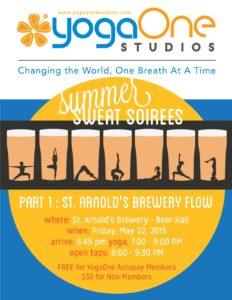
This brewery event, which featured a yoga class and two hours of open bar, pulled in 300 people.
You want the price to be high (and the event to be freaking cool) so that members can justify keeping their membership through the summer.
2) Video testimonials/AWESOME client or instructor features
Have a great story from a client or a powerful client transformation? A simple video interview with them can create great results. It’s also exciting for members to see their peers be featured and get inspired to come to the studio.
A note that you cannot display before-and-after imagery in Facebook ads – it conflicts with advertising policies. Focus on how your instructors and star students feel.
3) Earned Media
If you get some great earned media, like a TV spot or a feature in a magazine, boosting a post to your members with that announcement is great engagement.
For example, my friend Rachel, who owns Bar Method Houston, had a spot on local TV that turned out to be pretty humorous. (She tortured this poor guy!)
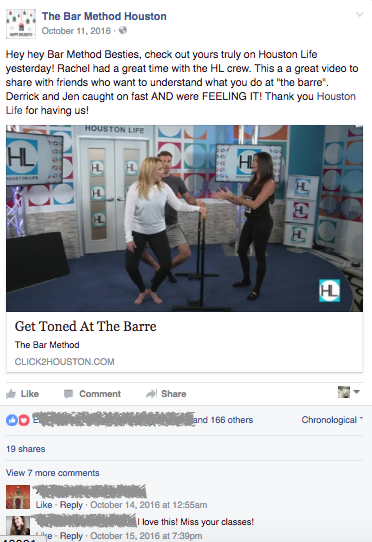
The studio repurposed this video later on and promoted it to their existing members, who LOVED it.
4) Useful tidbits
Most businesses already post here and there about helpful health and nutrition tips. THe problem though is that a lot of your followers don’t see your posts because of the Facebook algorithm.
Occasional boosted posts that feature useful tidbits are a great way to stay on members’ minds. You could boost to the people who like your page, boost to your email subscribers, or both.
(You wouldn’t want to boost these to cold traffic. You want these advertising dollars to remind your existing community why your studio benefits their health and wellness.)
One of the best fitness entrepreneurs who practices the useful tidbits approach is Jordan Syatt. His page, Syatt Fitness, has over 40,000 followers at the time this guide was written.

My favorite thing about Jordan is that I have never been sold ANYTHING by him in a Facebook ad. Yet I see his Facebook ads all the time.
Jordan creates helpful posts, and then boosts them to his page or his email list (I’m on both, so I can’t discern which) for visibility.
Here are a few I’ve screenshotted recently:
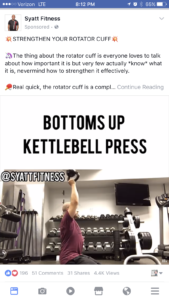
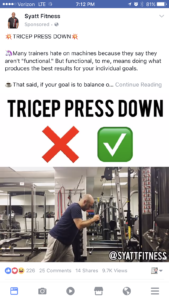
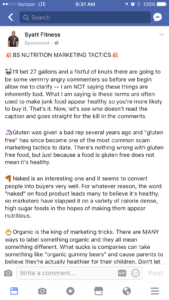
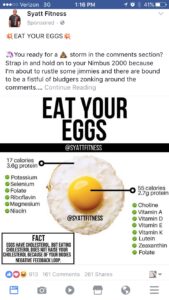
I saw all of these ads.
Jordan puts out a ton of content (as shown below), but I didn’t see a lot of these other posts because of the Facebook algorithm.
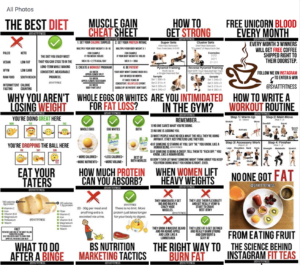
Tons of amazing free content that also establishes Jordan as a trustworthy, expert trainer.
When it comes to engagement, dropping a few bucks here and there to ensure your useful tidbits reach your audience is a great idea.
Chapter 7: The “Members Referring Members” Strategy: How Facebook ads can pump up your word-of-mouth referral
Back to our funnel:

Fanatics are the smallest audience in your funnel. Often it’s the audience that studio business owners are most familiar with. These are the people you see almost every day.
Fanatics are constantly refer you to their friends and give you amazing earned media in the form of testimonials. You see new students come in because their friend won’t stop talking about you. This audience is your most powerful audience – give this audience a clear path on how to refer people to your business and you’ll see a lift in quality traffic.
Now, referrals can be tricky. People might be hesitant about trying to sell for you and constantly refer all their friends.
We’ve seen it enough times when someone becomes a member of a network marketing company such as Rodan+Fields or Doterra, and suddenly they talk WAY too much about Lash Boost and how you have 24 hours to place an order. It comes off as inauthentic.
I propose two referral strategy options:
- Have a year-round referral incentive. (Don’t put this into a Facebook ad – it gets naggy). Market the incentive in your mailing list and member onboarding as a member perk.
Example:
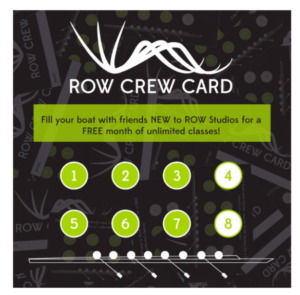
ROW Studios uses a referral punch card year-round for their members.
- Host a referral challenge – a concentrated period of time with a set end point – and run an ad to your members and existing community to capitalize on social tagging and social proof.
Advertise your referral challenge to your members
Similar to a challenge that encourages a fitness goal or attendance at the studio, like we discussed in chapter 3, you could also create and advertise a referral challenge. (Or do one that encourages BOTH, really.)
Elements of a referral challenge:
I encourage that you advertise to get people signed up for the referral challenge, so that everyone starts together and is registered.
You could create a simple landing page using LeadPages that allows people to get registered for the challenge – this makes for a clean registration experience.
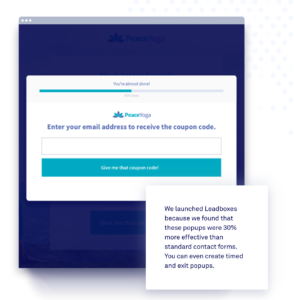
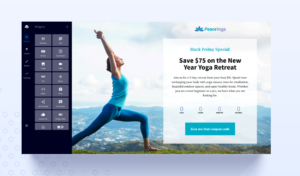
Leadpages allows you to create opt-in pages or special webpages in minutes, and starts at $25/month.
You can then send weekly or biweekly emails to your community during the referral challenge to keep them updated on progress.
*
Okay – your brain is buzzing with ideas. You are ready to DO this.
Rather than thinking of ads as the end-all be-all, you see how you they can be used sparingly or moderately to jumpstart your marketing.
In part three, we’ll shift from strategy to execution, and take a look at how to build a Facebook ad customized for the health and fitness industry.
Chapter 8: An extreme hand-holding tour of the Facebook Business Manager (including what you need to worry about and what you don’t)
You’ve done the strategic dirty work that 98% of businesses don’t bother with – amazing job!
Now it’s time to build a Facebook ad that supports your business goals.
In this chapter, we’ll look at how Facebook ad costs work. We’ll also look at the Facebook Business Manager and get clear on what buttons and dials you use to rock your Facebook and Instagram advertising.
“How do I get charged for Facebook Ads?”
This is the number one question I hear from business owners and entrepreneurs.
I get it. You hear horror stories where people spend a fortune, see no results, and antagonize their community in the process by looking sleazy.
Most of these business owners didn’t do the strategic work you’ve completed in the previous chapters.
They just drive in with a “buy from me now” advertisement on the very first pass. You’re not going to make that mistake.
Contrary to popular belief, you do NOT pay per click with a Facebook Ad. You set a budget, and then try to get the biggest results that you can on that budget.
If I post an ad for $10 and 100 people click on the ad, I will spend $10. If one person clicks, well, I will also spend $10. You always spend to your budget, regardless of performance.
You could run an ad on as little as $1/day to get your feet wet. You could also create a more aggressive strategy with multiple ads and audiences. Maybe you spend $10/day. Major national brands spend hundreds or thousands of dollars a day. It’s up to the advertiser.
Why Business Manager doubles team productivity
You can run a Facebook ad off of a personal account (literally connected to your personal account), or you can create a business manager account.
I recommend going over to a business manager page, because if something ever happens to your personal ad account, you can get locked out, or your Facebook business page can be abruptly deleted.
While you personally may not be a marketer or marketing several businesses at once, I just don’t want us to take any chances – especially if you want to have a team running this for you.
A video on how to set up Facebook Business Manager is here.
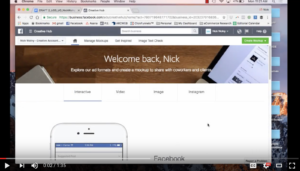
Let’s look at some of the different tabs you’ll commonly use in FB Business Manager. If they’re not listed here, don’t worry about them too much for now.
The only 3 ½ tabs to care about in the Facebook Business Manager
There are a truckload of screens you can end up on from the main menu. I personally spend 99% of my time in three (and a half) of the menu options.

Here are the main ones to worry about:
#1: Billing and Payment Settings
First things first – you’ll go to this tab to put a card on file and get your payment settings in order.

In the middle box, you can put a card on file. You can also reference any past invoices here.
Another cool feature in the far right tab is the Account Spending Limit. Here, you can set a max budget for your account. Let’s say you definitely don’t want to go over $250/month in Facebook ad spend. That would look like this:
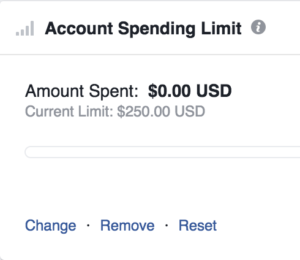
Set the budget to $250 at the top of the month, and then just hit “reset” each month. This way you can test different ads and campaigns, and don’t have to worry about accidentally going over budget.
#2: Business Settings

In the Facebook Business Manager, Ad Accounts are separate from your business manager account to start. (This allows a business to manage multiple accounts, for example. Or for another business to manage your account.)
The second half of the aforementioned video will show you how to pair your ad account to your business manager page.
3. Power Editor
The Power Editor is where all the magic happens – this is where you create ads.
You can also create ads in the Ads Manager tab. I prefer the Power Editor tab, because it’s a little easier and quicker to navigate.
The Power Editor tab gives you a snapshot of all of your campaigns and how they are performing.

I use the Power Editor so frequently that it’s actually bookmarked on my Chrome browser bar with the initials P.E.:

We go over the tabs of the Power Editor in detail in Chapters 9, 10, and 11.
3 ½).Pixels
I consider this a “half” tab, because I only use it to create or grab my Facebook Pixel.
The Facebook Pixel is code you can put onto a page of your website. You can then target people who visited your website in Facebook ads – pretty fancy!
The ability to see website traffic per page or per day isn’t new. But the ability to target those people in future Facebook ads makes Facebook a powerful marketing weapon.
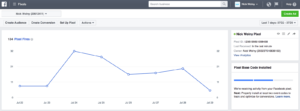
Since Facebook Pixel is a more intermediate concept, we go over it in Chapter 12.
An ad actually consists of three parts: The OBJECTIVE, The AD SET, and the AD itself. The structure kinda looks like this diagram.
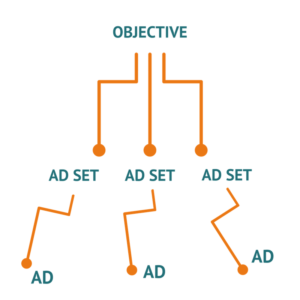
The next three chapters each break down an element of your Facebook ad. Each element is its own chapter for easy reference.
First we’ll set your objective – your marketing goal that guides all of your ads.
Then we’ll create one or more ad sets, in which you select your audience, budget, and placements.
Finally, we create your ad – the content that your audience will see.
First up: your objective.
Chapter 9: Objectives: Choosing the right ad structure for your business goals
Facebook as are created in the Power Editor tab.
When you go to create a campaign, you are taken to this screen:
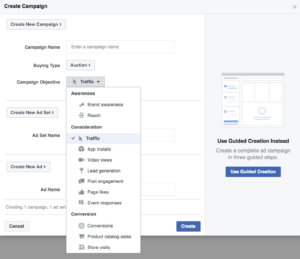
The first part of our ad is called the objective. In all, there are twelve objectives to choose from, but as a fitness business owner we will focus mostly on video views and traffic.
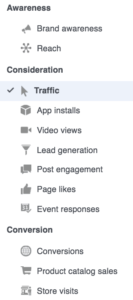
Here’s why the objective matters.
Imagine that you pick an objective and target an ad to an audience of 50,000 people.
Depending on your objective, Facebook will show your ad to the people that have a track record of fulfilling that objective first.
So if you want video views, Facebook will show your ad to the people in your audience that tend to watch videos the most.
If you choose traffic and are wanting people to click, Facebook will choose people who have a track record of clicking.
With a Video Views objective, you’ll reach more people and your ad will look like a regular post.
For traffic, however, you’ll have a button and headline beneath your post that you can customize.
The Video Views Objective
The great thing about a Video Views ad is that it looks like a regular Facebook post. People use Facebook predominantly to stay connected to friends and family, so when they see extra buttons and tabs, they scroll past.
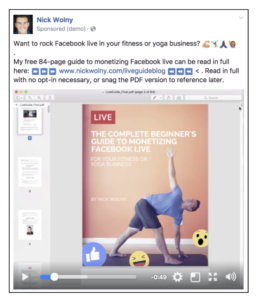
A video views ad doesn’t have any buttons and looks natural.
You could add a link in the status as shown here.
Sometimes people don’t even realize this post is an ad, as a friend pointed out when I asked her how she feels about sponsored posts
In my opinion, this is THE objective to use for anything engagement-related – your Charming First Date ad should definitely be video views, and any other ads you want to use could also be video views.
You can also put a link you want people to click into the status of the post if you choose. (Facebook won’t pick up the cost per click in its metrics though, since the objective is video views.)
But the ad structure itself will not have a button, and your performance will be measured by how much each 3-second view costs.
The Traffic Objective
When you ask for action, you run a traffic ad.
Here’s the thing – traffic ads have buttons, and are usually asking people to click the button and leave Facebook. People won’t casually take you up on that – so you want your offer to be complete and focused.
Also, at this point, your audience is warm – they’ve already seen you or have bought from you in the past.
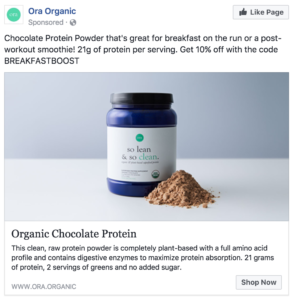
In a traffic ad such as this one, a button appears in the bottom right corner.
A couple other objectives that are red-headed stepchildren, but still children, therefore you could consider them
Event Responses
You’ve probably seen sponsored posts for events before. I don’t love them because people RSVP to the event on Facebook (which means nothing these days) and it’s difficult to measure true conversion. You also don’t collect their contact information for future targeting.
However, people have been seeing Facebook events for years – they understand what Facebook events look like. It’s also authentic to advertise an event – people give you a pass on being sales-y, because event promotion is expected.
Approach this ad in the same way that you would budget for printed materials to put up at a coffee shop – eyeballs will see it, and perhaps more people will come as a result of hearing about it.
Page Likes
If you have a larger advertising budget, you could run a Page Likes ad as engagement for your list, or for people in your “video views” audience.
When people like your page, they’ll see more updates from you, and “people who like your page” is an inexpensive audience to target.
You can run a “Page Likes” ad for as little as $1/day. In my Facebook Live guide, I point out that the advantage to growing your Facebook page is that your live audiences will get bigger and bigger.
This strategy, while effective, should come after you have revenue-generating ads such as video views and traffic in place first.
You can then cross-post any media, challenges, or promotions on your social media. The advantage here is that the Facebook platform enables social proof and tagging – if people want to tell their friends about your promotion, you make it super easy.
Here’s the trick with a page likes ad – asking for likes outright feels inauthentic. Instead, you should speak to WHY people should like the page. What will they get access to? What do they risk missing out on if they DON’T like the page?
Give the viewer something useful, the same content that you would use in a regular post.
My buddy Brian does that with a page likes ad.
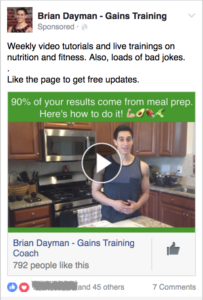
A page likes ad will have a large “thumbs-up button” for easy following.
Brian is an online personal trainer who does free live workshops and Q&As on how to eat right and improve in the gym. It makes sense for him to build a larger Facebook page, because people connect with him online.
Over time, he creates helpful videos and lessons, and occasionally he invites you to join his mailing list and get some free gifts.
He’s also seeing some pretty great results – here’s a snapshot of his first month. Brian has also gotten clients from the content on his Facebook page.
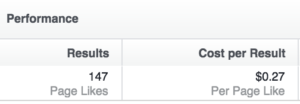
For Brian, page likes work – his videos pull people toward his list, and his audience sees him as an expert in the industry.
Now you understand how the objective shapes your Facebook ad. Next, we’ll tackle your ad set, where we determine who we want to be in front of and how often.
Chapter 10: Ad Sets: Identifying your ideal audience and budget
This is the section that most advertisers mess up. The ad set is where we define your AUDIENCE.
Your ad set is comprised of:
- Your Budget and Schedule
- Your Audience
- Your Device Placement and Optimization
Let’s go through each one in rigorous, glorious detail.
Budget and Schedule
For most ad types, you’re charged for daily reach. To be clear – you’re not charged by the click. People get confused because they see a metric called “cost per click” in their ads manager, which looks like this.
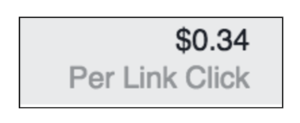
This is different than Google AdWords, the other dominant platform for paid advertising, where you pay only when someone clicks. Here, you are not paying $0.34 per click – the average cost-per-click of your campaign is $0.34. So by all means, drum up more clicks!
In this example, I’ve named my ad set “Sample Ad Set 1”.
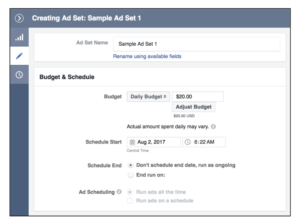
Under the Budget & Schedule heading, you first choose between a lifetime budget for the ad, or a budget per day:
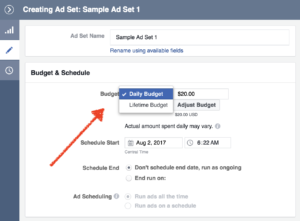
The daily budget is pre-set to $20 a day; the lifetime budget is set to $500. These are too high for an initial ad; you want to run your ad on a lower budget to start to see if it resonates with your audience before you drop the big bucks.
If you do a lifetime budget, you can also specify the time of day and which days you would like your ad to show.
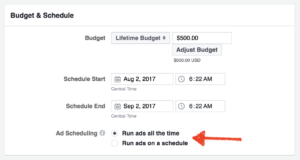
For example, I could specify that I only want my ad to run from 8am-5pm on weekdays. That would look like this:
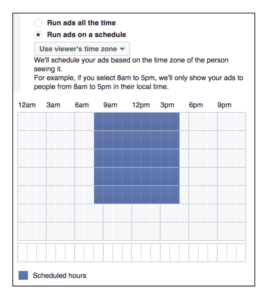
Audience
Audience has SO many bells and whistles that it’s easy to develop analysis paralysis.
The depth of audiences is also why Facebook ads are so unique – Facebook has LOADS of information not only on where people are, but how people behave.
Every time you like something, watch a video for three seconds, log into another app using your Facebook account, and so on, Facebook adds little notes and data points to your account.
To keep things simple, I’ll split this section into two sections: Cold audiences and Warm audiences.
Cold Audiences
Reminder – you would pick this audience when you want to create awareness for your business. You’re in this stage of your funnel:
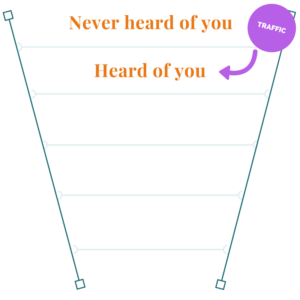
In a cold audience, you can target people by their demographics, interests, and behaviors.
To help create a cold audience, here is a video on cold traffic.
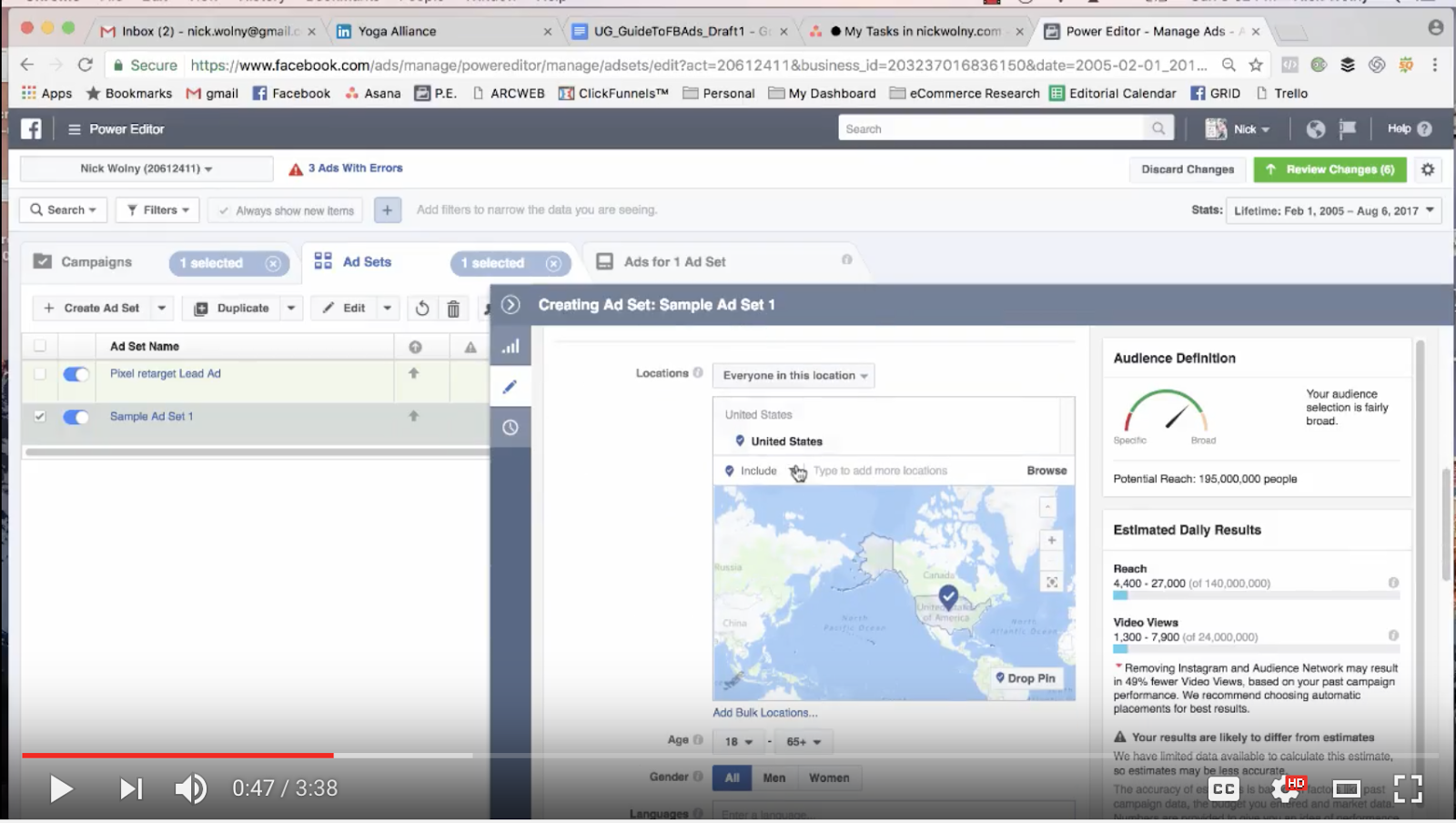
Warm audiences
Warm audiences will be a lot more receptive to your advertising efforts, because they’ve already seen you. In contrast to a cold audience, your focus is now here:
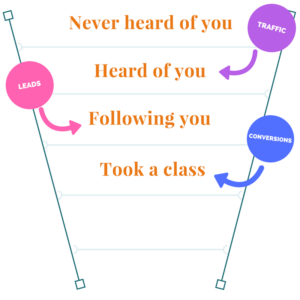
We’ve discussed warm audiences throughout this guide. A few examples include
- People who viewed your “Charming First Date Ad” and are video views
- Users who like your page
- Your email subscribers
These audiences are called custom audiences. You will have Facebook create an audience of people who have already interacted with you in some way.
To target a warm audience, watch this video.

Lookalike Audiences
I LOVE THIS AUDIENCE. Sorry – just had to get that out real quick.
Let’s say you have a warm audience already – an email list, or a group of people who have watched your videos.
You can ask Facebook to create a “Lookalike audience” – an audience of users that behave most similarly to that warm audience. Pretty incredible!
I recommend that you take your video views from your Charming First Date Ad, create a lookalike audience from those viewers, and point your Charming First Date Ad to your lookalike audience instead.
Technically, your lookalike audience is cold – they haven’t seen you before. But they behave the way your members and most interested fans do – so it’s worth getting in front of them.
This video will show you how to create a lookalike audience.
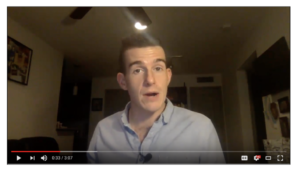
Placement and Optimization
You have the option to choose automatic placements or edit your placements.
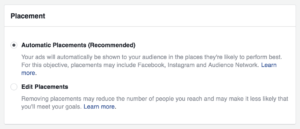
Always choose “edit placements”. That brings you here:
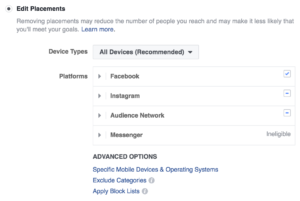
First, you can choose to only be on a specific device. Choose “all devices”, “desktop only”, or “mobile only”.
Next, you have platforms. Let me open up all of these drop-down menus for you:
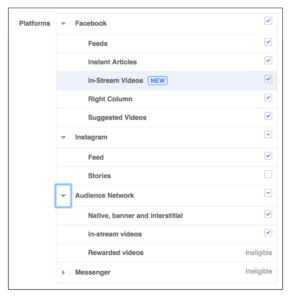
Tons of options – I know. To start, I would uncheck EVERYTHING except for “Feeds”, which is your news feed, and Instagram Feed if you want to be on instagram.
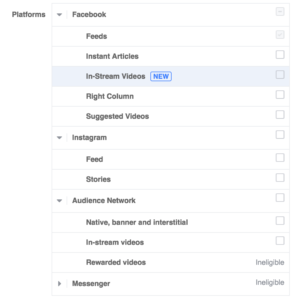
The other options are more for right column, ads that appear in articles, and ads that will appear as commercials in other videos.
In the next chapter, we’ll hit on some formatting notes you should consider when running an ad on Instagram.
Finally, in the optimization & delivery section, you can tinker with delivery. Leave everything as is in this section for now,
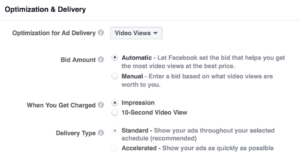
Whew! We’ve knocked out a lot of the nitty gritty back-end stuff that dramatically affects your ad’s performance and success.
Now let’s go on to the fun part – the actual content of the ad that your audience will see.
Chapter 11: The Ad Itself: How To create a killer ad that makes viewers take action NOW
Your stage is set. Your audience is clear. Now it’s time to create your actual ad.
You’ve done all this hard work – so we don’t want to lose people over bad formatting or an image/video that doesn’t get the point across.
In this chapter, we will set up your ad and tweak your ad copy (words) to maximize conversion.
The Ads Tab In Power Editor
Open your ads tab and ad of choice. First, you’ll set the page that we want to run the ad for, and set up Instagram integration if you are running your ad on instagram.
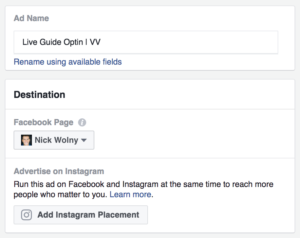
Next, you’ll decide whether you want to create an ad, or just use an existing post.
I’ll review existing post first since it’s simpler. With existing post, just click the “Enter Post ID” link, which will bring up a blank box.
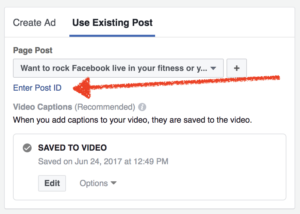
Then you enter the ID of your post.
“WTF is that,” you ask? The “post ID” is a long number displayed at the end of a post’s URL.
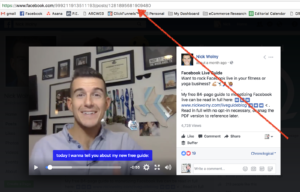
It’s this long-ass number at the end of the URL.
You can find this URL on any post by clicking the DATE or TIME the post was published.

That’s it! Easy peasy.
If you choose to create an ad, you’ll be making a brand-new post. These are posts you would target to specific audiences and are perhaps not announcements you want everyone to see.
This video on the next page shows you a tutorial on how to set up your Facebook ad, and also how to easily and quickly add captions to videos within Facebook.
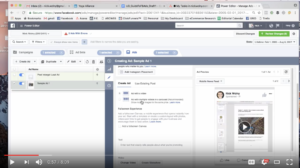
Your Video
I have a few notes on video.
First, as mentioned in the tutorial above, include captions on your videos. 90% of people will watch your videos with the sound off. Here are some of my stats:

Shoot your video with that in mind – assume your video will have captions, and avoid putting any important information in the bottom third of your videos.
Image Considerations
In some of your ads, you won’t need to worry about racking up video views. Or maybe you just don’t have time to create another video. Create an image instead.
Keep in mind that with an image, your dimensions should be 1200×628, and you should have less than 20% text across the image. Otherwise the reach of your ad could be compromised.
Facebook offers an image checker, where you can quickly see if your image has under 20% text. I keep it bookmarked here.
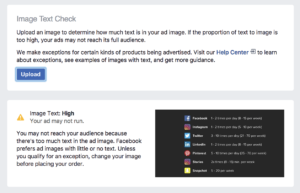
Cross check your images before you complete your ad using the image text checker.
A Crash Course In Social Media Copywriting
“Eye Tracking” is the study of where eyes fixate on a page. Hundreds of online studies show that your eyes are trained to track back to the left again and again – people read online websites and articles in an F pattern.
You want to make it as easy as possible for people to read your posts and ads. Too often I see a post of ad that is just a massive wall of text. It’s intimidating to focus and read all of that when I just saw six cat videos beforehand.
You’re also reading in an F-pattern throughout this guide. You’ll notice there aren’t too many paragraphs of blocks of text that are multiple lines.
This is because long blocks of text fatigue your eyes more quickly and drain your attention.
What we say matters, yes, but so does the delivery of that information on a screen.
I personally go one step further, and place a dot or symbol between each line, to ensure there is a nice healthy line break. Amy Porterfield, an online marketing strategist and podcaster, breaks up her lines with symbols for readability.
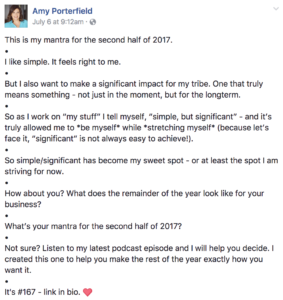
I personally use periods, which looks like this:
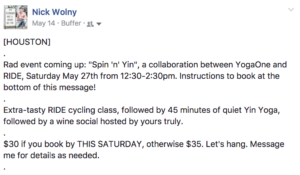
Keep these design tips in mind as you put together your content.
I suggest your ad have a callout at the top – this “wakes people up” that your ad is for them. Call out your city, your members, et cetera. I like to put this callout in brackets.
From there, land your point in 1-2 sentences. This way the people who don’t click “see more” will still understand the intention of your ad.

I can add more text lower in this ad copy if I choose to. However, I land the point in the first couple of sentences.
You now have what you need to build your first Facebook ad – as well as clarity on who you’re targeting.
In the final part of this guide, we’ll measure your results, save some bucks, and use ads to sell more of your high-dollar programs.
Chapter 12: “Is This Good Or Bad?” Measuring The Results Of Your Facebook Ads
You’ve set up your ad and now it’s running! But how is it doing? What defines “good”? And how in the hell do I read all this stuff?!
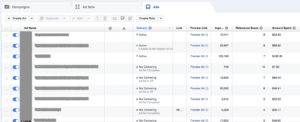
In this chapter, I’ll give you a rundown on how to monitor your ads and adjust, so that you’ll know how they’re doing.
The one metric that tells you whether people are actually interested in your ads
Once your ad reaches 500 people, you’ll begin to see a number called the “relevance score”.
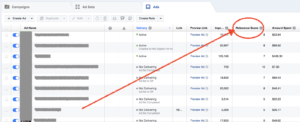
The relevance score ranks how well your ad resonates with your target audience on a scale of one to ten.
Remember when we set your audience, and Facebook gave us a range of people our ad would go in front of?
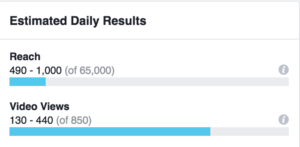
Where you are in this range depends on how “relevant” your ad is. Facebook does this in an effort to create a great experience for its users.
If your target audience is enjoying your ad and engaging with it, you’ll get a higher relevancy score, and Facebook will reward you by showing your ad to more people – the higher end of your range of reach.
If your audience is less responsive, you’ll be penalized with lower reach.
For your Charming First Date Ad, aim high – you should be able to hit a relevancy score of 7 or higher. If you’re below that, consider running a variation of your ad with a slightly different audience or message to lift your score.
For other ads in which you sell, promote, or announce events, a lower relevancy score is okay – especially since your audience is smaller and more focused.
A low relevancy score isn’t necessarily bad. For example, if a realtor ran a Facebook ad for a home, and had little interaction, but ended up selling the home as a result of the ad, the relevancy score doesn’t matter too much.
Relevancy score just goes back to reach. The higher it is, the more people you reach for the same price.
How to split-test an ad in five minutes flat
If your relevancy score is sub-par, split-test your ad and change ONE thing. Otherwise you won’t know which variable made the difference.
Maybe it’s the ad copy. Or perhaps you target a slightly different audience. Maybe you want to split-test women versus men to see who responds more to your ad.
Whatever you decide, you can quickly duplicate your ad, ad set, or entire campaign using the “Duplicate” button.

When you split test, I strongly recommend you duplicate at the Ad Set level. Even if you want to test something like two different images or two different headlines, duplicate your ad at the ad set level.
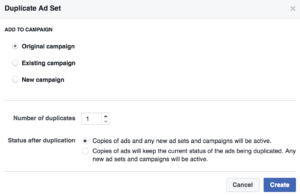
I like to keep the same campaign, and duplicate the ad set.
Rick Mulready, a leading Facebook Ads expert and host of the podcast The Art Of Paid Traffic, notes that when you try to run multiple ads at the ad level, Facebook will try to determine the top performer within hours of you running the ad. It will then run all of your traffic to what it thinks is the winning ad.
It takes more time for an ad to really be broken in – usually a day or two – so be patient and watch your relevance score.
How to point different audiences to the same ad to maximize social proof
If you created an ad for your initial campaign, your duplicate will create another ad. We want to stack all our likes, comments, and other social proof into one post.
To do this, first get the “Post ID” of your existing ad. To get that, you’ll go to your ads tab and pull open the existing ad in the editor.
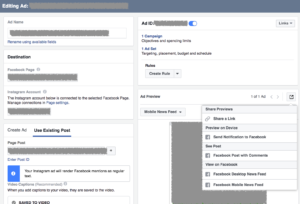
Under the “Ad Preview” in the right column, there’s a little pop-up box button. Click that, then click on “Facebook Post with Comments”.
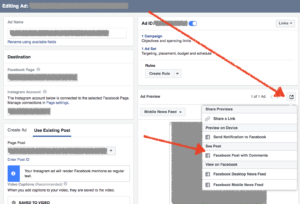
This will take you to the post URL. From there, you can snag the Post ID – it’s at the end of the URL.
![]()
Now you can paste that ID into any duplicate ads in the “use existing post” section, which will point your new ad sets to the exact same ad.
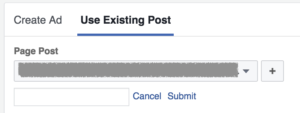
And there you go! Now you can test different ads and audiences to find the best deal. You’ll also preserve your social proof and ensure better reach on your paid efforts.
If you’re still with me, I have one more tool I want to introduce to you.
It takes multiple revenue streams to run a killer fitness business – and some of you have a more lucrative offer, such as personal training, a certification, or a teacher training.
So in our final chapter, I’ll show you how you can run follow-up Facebook ads to people who visit a webpage of yours. How cool would it be if people visited your personal training or teacher training page for more information, and then saw reminder ad at a later date with a promotion or special offer?
We can do that using a weapon called the Facebook Pixel – and it comes next.
Chapter 13: Sell more teacher trainings, workshops, and certifications with the Facebook Pixel
A teacher training can equal thousands of dollars in profit per client. The same is true for personal training packages, retreats, and intensives.
So if you could get in front of the people that are already showing interest in these programs, you would likely be on their mind more, persuade them more, and convert more of them into paying clients.
You can get Facebook Ads in front of your website traffic using a tracking code called the Facebook Pixel.
If Sally browses your Pilates studio’s website, and doesn’t sign up for anything, you can actually run an ad to just her, offering her an additional touch point or discount to get her interested.
This isn’t the first time she’s seen your studio, so she would be warm traffic – and your ad will run as long as you like.
How to quickly and easily set up your Facebook pixel
We briefly touched on the Facebook Pixel tab in Chapter 8. Find the pixels tab in your Facebook Business Manager. You’ll come to this screen:
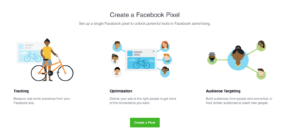
Create your pixel. You’ll come to this screen, where you can name your pixel.
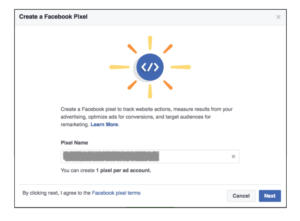
Once your pixel is created, you have an option on how to use it. I recommend you copy and paste the code – the second option.
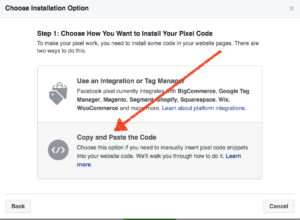
From here, you’ll be able to copy the code. Don’t invest too many brain cells into all the different numbers and letters of the code – just click to copy it.
If you’re installing your code on your own website, click the link in section 1.1 for a reference on where to place your code. Generally, it’s in the “head tracking” section of a webpage.
If you have someone else manage your website, there is a button at the bottom of this section where you can email your code and instructions to them.
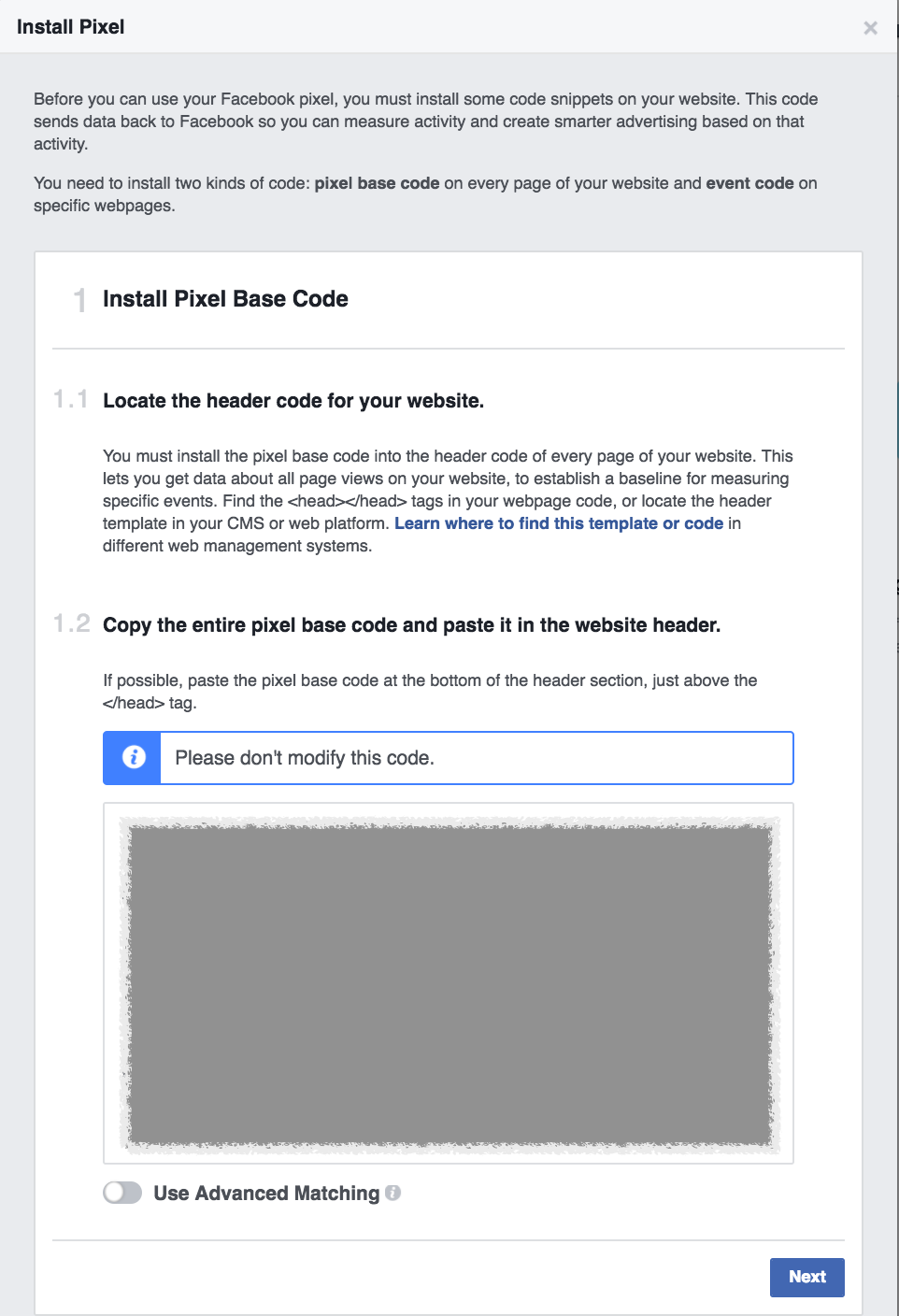
Don’t worry about section 2 for now – you can add events tags later.
Section 3 shows you how to confirm if your pixel was installed correctly. You’ll be able to see this activity on your Pixels tab.
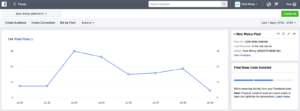
Use Facebook Pixel to promote high-dollar programs such as teacher trainings or certifications
Now that you have your Facebook Pixel up and running, people who visit a certain page of your website can become a custom audience.
Let’s say you are a yoga studio and you have a page that is all about your yoga teacher training. It’s a $2,500+ program.
In the weeks before your next training, you would advertise to people who visited this page. You do this in the ad set, where we create our audience.
First, create a new custom audience.
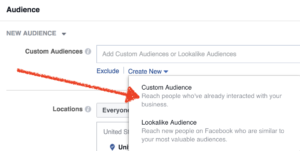
Choose “Website Traffic”.
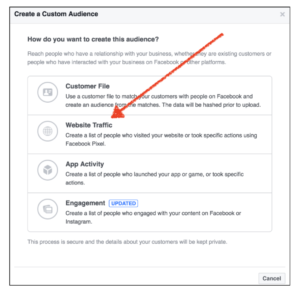
For this example, you would choose “people who visited specific web pages”.
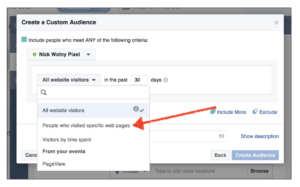
You could also refine further by frequency (targeting people who have visited multiple times) or who have visited one page, but not another.
This is how retail businesses stalk you – they see that you visited a product, and they also see that you never made it to the “thank you” page from purchasing that product.
So they target you repeatedly to scoop up some of the people who abandoned their cart.
You can then create an ad or series of ads for your high-dollar program when it’s about to start.
HOLY CRAP, WE DID IT!
Whether you crushed this guide from cover to cover, or just read a page or two, I’m grateful – THANK YOU.
If you found any part of this guide useful, and want to share it with your community, feel free to pass along the following link: www.nickwolny.com/adsguideblog
You can also post this link to Facebook, LinkedIn, Twitter, or with your personal network. Here’s a quick little write-up you can copy and paste to save time:
—
[Health and fitness entrepreneurs and business owners]
I recently read an ultimate guide on using Facebook Ads in the fitness industry and really enjoyed it. In this guide I learned
- How to use Facebook to grow business revenue, without being slimy or sleazy
- How to not blow your budget when using Facebook ads
- The best, most lucrative promotions – and the best time of year to do them
You can check it out here: www.nickwolny.com/adsguideblog
—
If you do decide to share, feel free to tag me in the post!
See you soon.
Nick





